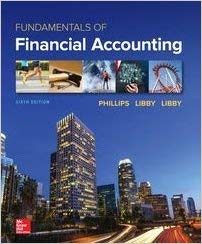Question
1)For each of Company A's transactions that occurred during Year 2 described below, select the appropriate dollar effect, if any, on Company A's Year 2
1)For each of Company A's transactions that occurred during Year 2 described below, select the appropriate dollar effect, if any, on Company A's Year 2 statement of changes in equity.
Transactions:
- On January 15, Year 2, Company A issued 20,000 shares of its $1 common stock for the market price on that day.
- On February 1, Year 2, Company A paid a cash dividend of $50,000. The company declared this dividend on December 15, Year 1.
- On March 20, Year 2, Company A declared and distributed a 10% stock dividend on shares of common stock outstanding.
- On May 12, Year 2, Company A declared and distributed a cash dividend of $70,000.
- On September 9, Year 2, Company A acquired 30,000 of its own common shares at the market price. Company A uses the cost method of accounting for treasury stock.
- Company A reported a net loss of $40,000 for Year 2.
The market price per share of Company A's stock on selected dates can be found in the Exhibits Tab.
This is Exhibits Tab:
Date Market Price Per Share
Jan 15, year 2 $15
Feb 1, year 2 $14
March 20, year 2 $18
May 12, year 2 $17
Sep 9, year 2 $20
Dec 31, year 1 $9
Determine the applicable dollar value for the effect that each transaction described above has on Company A's Year 2 statement of changes in equity. Enter a positive amount for an effect that increases the total equity balance and a negative amount for an effect that decreases the total equity balance.
Balance at January 1, year 2 . Common stock $1 par ($130,000), Additional paid-in capital $200,000, Treasury stock $0.00, Retained earnings $630,000, Total Equity $960,000
(Answer the following questions)
1) January 15, Year 2. Calculated the common stock, additional paid-in capital, treasury stock, Retained earnings, Total equity.
2) February 1, Year2. Calculated the common stock, additional paid-in capital, treasury stock, Retained earnings, Total equity.
3) March 20, Year 2. Calculated the common stock, additional paid-in capital, treasury stock, Retained earnings, Total equity.
4) May 12, Year 2. Calculated the common stock, additional paid-in capital, treasury stock, Retained earnings, Total equity.
5) September 9, Year 2. Calculated the common stock, additional paid-in capital, treasury stock, Retained earnings, Total equity.
6) December 31, Year 2. Calculated the common stock, additional paid-in capital, treasury stock, Retained earnings, Total equity.
7) Balance at December 31, Year 2. Calculated the common stock, additional paid-in capital, treasury stock, Retained earnings, Total equity.
2) Select from the option list provided the effect (increase, decrease, or no effect) each transaction below will have on Mart's common stock account. Each choice may be used once, more than once, or not at all. The state in which Mart is incorporated requires capitalization of retained earnings in the amount of the par value of the shares issued when a stock split in the form of a dividend occurs.
Transaction Answer
1. Mart declares and distributes a 10% stock dividend. x
2. Mart retires 5,000 of its outstanding shares of common stock. x
3. Mart acquires its own stock to hold as treasury stock using the cost method. x
4. Mart issues a 3-for-1 stock split. x
5. Mart issues 1,000 previously unissued common shares at $25 per share. x
6. Mart declares and distributes a 30% stock dividend. x
7. Mart distributes a dividend of $1,200,000. Only $900,000 is in retained earnings to distribute as a cash dividend. x
Step by Step Solution
There are 3 Steps involved in it
Step: 1

Get Instant Access to Expert-Tailored Solutions
See step-by-step solutions with expert insights and AI powered tools for academic success
Step: 2

Step: 3

Ace Your Homework with AI
Get the answers you need in no time with our AI-driven, step-by-step assistance
Get Started


